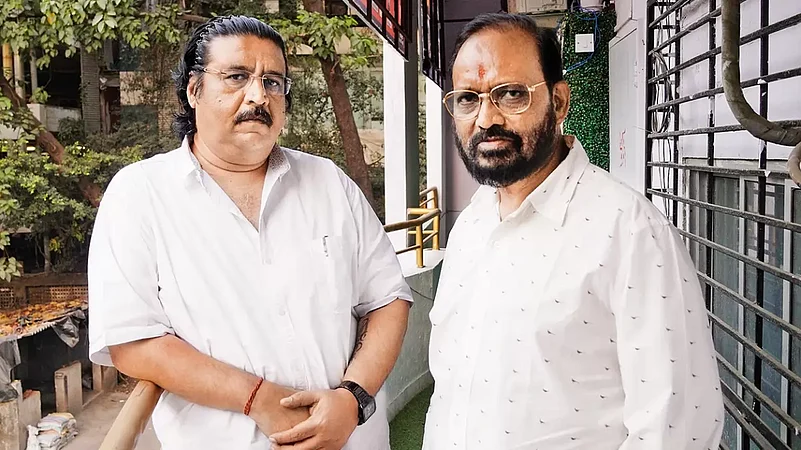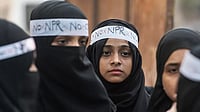MumbaiI: The office of the Federation of Western India Cine Employees (FWICE), located on a busy road in Andheri, a northern suburb of Mumbai, is full of cupboards. They cover an entire wall in the room with a long oval-shaped table and a dozen chairs. The cupboards are full of files with complaints for redressal from the 31 film unions affiliated to FWICE. Every file represents an aspiration of the three lakh—of five lakh—members working in the film industry. In each of those files is also the hope of a better life. The room, with its 12 chairs, has acquired a larger-than-life persona, for it is here that decisions with far-reaching impact concerning film folk are taken.
In recent times, the challenge for FWICE has been to find employment for its members who have lost jobs or cannot find jobs in the Hindi film industry in a post-Covid-19 era. Though the industry has been the biggest employer, the long months of the pandemic lockdown saw it plummet into a financial crisis. With a slew of failures—including films by big banners with A-list actors—at the box office, producers are now shying away from regular feature films. Like every other industry across the world, the lockdown months saw the Hindi film industry grind to a halt with a vast majority of people working in it reduced to penury. The Federation was inundated with requests from unions for funds for the needy.
“This was a huge challenge before the Federation,” says BN Tiwari, president of FWICE. “We got in touch with directors, producers, production houses and stars to help the needy workers of the film industry. The federation collected Rs 48 crore and disbursed it to those who needed financial assistance,” adds Tiwari.
FWICE has completed 60 years in the Indian film industry. Its focus is to create an amicable work environment on film sets. There are six federations across the country which, between them, represent all the film industries in India. With the Hindi film industry – one of the largest film industries in the world – headquartered in Mumbai, the FWICE is the most powerful federation in the country.

Tiwari laments the practice of long working hours. The daily soap operas on various TV channels have brought in long working hours wherein employees work without a break for days on end. “Employees are sleeping in the offices, waking up ready for the next shift. We are trying to negotiate with TV channels and producers to bring in shorter working hours and reduce the number of days a particular serial is aired. There are actors fainting on the sets and film workers getting burnt out. This must stop. Channels have to start getting realistic about the health of the people delivering those serials,” says Tiwari.
Dilip Pithwa, member of the General Council of FWICE, points out that even inter-state disputes are settled through interactions with the other federations. “Often, when they are working for regional films in another state and a member is not paid his or her dues, we contact the regional federation there to take up the issue. There have been successes in settling such disputes,” says Pithwa.
The latest issue being aggressively taken up by FWICE is the employment of foreigners in the Hindi film industry. Increasingly, foreigners are being hired as cinematographers, script writers, directors, in production, and as junior artistes and dancers. According to Tiwari, a majority of these foreigners are from the United Kingdom, Russia and Uzbekistan. Film unions representing employees from various fields in the industry claim that foreigners are also being hired as make-up artists, hair stylists, action directors, stuntmen, costume designers, art directors and technicians to work in the film industry. The labour-intensive Hindi film industry is a great attraction for foreigners. The unions claim that producers and coordinators are unwilling to discuss the issue of employing foreigners at the cost of Indian jobs. Tiwari is of the opinion that there must be a ratio for this employment and it cannot be at the cost of the livelihoods of Indian film employees.
There have been instances where union members have gone to court to protest against the rules imposed by unions to which they are affiliated. For several decades, the Hindi film industry followed the tight rule laid down by the Cine Costume and Make-up Artists Association (CCMAA) that women could not be employed as make-up artists and only men could be registered as its members. In 2013, Charu Khurana, a make-up artist, challenged this gendered bias. In 2014, the Supreme Court struck down this rule. The apex court had also stated in its order as ‘unconstitutional’ the rule which made it mandatory for a make-up artist to be a domicile of a particular city for five years to become a member of the CCMAA.
Though the conversation regarding gender inequality in pay has picked up speed with top actors like Deepika Padukone, Tapsee Pannu, Aditi Rao Hydari, Kangana Ranaut, Kriti Sanon and others, speaking up against this practice, there is a deafening silence around the issue in the industry. Deepika Padukone and Priyanka Chopra, to take two examples, are paid much less than their male co-stars who make four to eight times what they make, despite being very bankable actors and recipients of much critical acclaim and box office success.
Though they have started questioning this glaring disparity, so far, no strong move has been made to rein in the gender disparity in the pay grade for actors. Women in other departments too are paid much less than their male counterparts. “The unions are not taking up this issue. We work the same hours, do the same amount of work, yet our pay package is way below that of a male worker,” said Reema, a production assistant. This is a reality the federation has been slow to engage with.
Membership to the Junior Artistes Association is the most sought after one in the Hindi film industry. An applicant to the association is given a card and category based on their age and appearance. The ‘A’ category, which is termed ‘Decent’ belongs to those who fit into the traditional parameters of what is considered good-looking. Members of this category are tall, fair, young and physically fit and can therefore look ‘wealthy’ in films. The ‘B+’ category is reserved for the roles of goondas (rowdy elements), morcha wale (protestors), gaon wale (villagers) or for funeral scenes. The lowest in the rung are the ‘Talk Show’ category who have to fill in seats for talk shows. They are holed up in the studio for hours, forbidden from taking even washroom breaks and are paid a pittance. FWICE is negotiating with production houses to get junior artists and others a minimum of 25 days of work per month. “The federation has drawn up a price list of minimum wages to be paid to the daily wage workers. This must be adhered to by all film makers and production houses,” said Pithwa.
A glaring disparity in the Hindi film industry is the prevailing class divide in the food supply system during filming. Everyone eats in a separate area earmarked for them with these spaces being sacrosanct and unbreachable. The caterers are different for every rung of employees on a film set. The top rung actors—both male and female—and directors and producers of the film are the A-listers who get food delivered by expensive caterers; the next rung, comprising the heads of the various departments, have a another caterer. There are at least five to six caterers on a single film set feeding the different categories of people working there. “The quality of food given to the lowest rung of people on the film sets can be much better. But that never happens. Though cinema-making should be without such class divides, it is not the case. The biggest class segregation is on a Hindi film set,” said Paresh, a spot boy. “We are negotiating to bring in more equality on the film sets,” said Tiwari.
An important component of the functions of FWICE pertains to negotiations on compensation for film workers. According to Tiwari, the federation demands compensation for the period from a film worker leaving his or her home for work to until the time the person reaches home. However, not every production house or film maker listens to the federation’s demands. The highest compensation FWICE has been able to negotiate is Rs 35 lakh for the family of a deceased film worker, considered as a record of sorts. “When a production house or film maker does not listen to the demands of the federation, we ask the film workers on the sets to adopt a ‘go-slow-with-work-and-eventually-stop-work’ policy. With so much money at stake if a single day’s shooting is missed, the production houses ultimately implement our demands,” says Tiwari. The federation has also entered into an agreement with the SVF Hospital in Goregaon, another suburb in north Mumbai, to provide treatment to film workers who are members of the unions affiliated to FWICE - without having to pay in advance.
The FWICE is spearheading the construction of the Dadasaheb Phalke Housing Colony, spread across 253 acres at Shelu in Karjat, for film workers on easy installments. Built under the Pradhan Mantri Awas Yojana, these one bedroom-hall-kitchen flats will be part of a project of 50,000 houses to be constructed over a period of three years. In the first phase, 15,000 houses will be constructed and handed over by the end of 2023.
The various Hindi film industry unions are also connected to political parties such as the Indian National Trade Union Congress (INTUC), Shiv Sena, NCP, BJP and MNS. In recent years, unions have started approaching political parties for redressal of complaints and this has given these parties leg space in the industry. “Yes political unions are also present. They are more disruptive than constructive. The federation understands the issues facing the film employees better than the political parties,” saysTiwari.
The ambitious plans of the federation include: skill development for film workers to upgrade and increase their chances of employability; free medical facilities to all industry workers; well-equipped ambulances at film sets in Mumbai and Greater Mumbai; medical and educational aid to FWICE members and their dependents and insurance and provident fund to all industry workers. The federation wants to hold discussions with the government to make all these provisions mandatory for all film industry workers.
(This appeared in the print edition as "Democratising Film Work Culture")


























